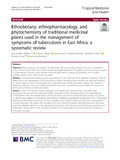Ethnobotany, ethnopharmacology, and phytochemistry of traditional medicinal plants used in the management of symptoms of tuberculosis in East Africa: a systematic review
Date
2022-08-14Author
Obakiro, Samuel Baker
Kiprop, Ambrose
Kowino, Isaac
Kigondu, Elizabeth
Odero, Mark Peter
Omara, Timothy
Bunalema, Lydia
Metadata
Show full item recordAbstract
Objective
Many studies on the treatment of tuberculosis (TB) using herbal medicines have been undertaken in recent decades in East Africa. The details, however, are highly fragmented. The purpose of this study was to provide a comprehensive overview of the reported medicinal plants used to manage TB symptoms, and to analyze scientific reports on their effectiveness and safety.
Method
A comprehensive literature search was performed in the major electronic databases regarding medicinal plants used in the management of TB in East Africa. A total of 44 reports were retrieved, and data were collected on various aspects of the medicinal plants such as botanical name, family, local names, part(s) used, method of preparation, efficacy, toxicity, and phytochemistry. The data were summarized into percentages and frequencies which were presented as tables and graphs.
Results
A total of 195 species of plants belonging to 68 families and 144 genera were identified. Most encountered species were from Fabaceae (42.6%), Lamiaceae (19.1%), Asteraceae (16.2%), and Euphorbiaceae (14.7%) families. Only 36 medicinal plants (18.5%) have been screened for antimycobacterial activity. Out of these, 31 (86.1%) were reported to be bioactive with minimum inhibitory concentrations ranging from 47 to 12,500 μg/ml. Most tested plant extracts were found to have acceptable acute toxicity profiles with cytotoxic concentrations on normal mammalian cells greater than 200 μg/ml. The most commonly reported phytochemicals were flavonoids, terpenoids, alkaloids, saponins, cardiac glycosides, and phenols. Only Tetradenia riparia, Warburgia ugandensis, and Zanthoxylum leprieurii have further undergone isolation and characterization of the pure bioactive compounds.
Conclusion
East Africa has a rich diversity of medicinal plants that have been reported to be effective in the management of symptoms of TB. More validation studies are required to promote the discovery of antimycobacterial drugs and to provide evidence for standardization of herbal medicine use.
URI
https://doi.org/10.1186/s41182-020-00256-1https://tropmedhealth.biomedcentral.com/articles/10.1186/s41182-020-00256-1
http://ir-library.mmust.ac.ke:8080/xmlui/handle/123456789/2477
Collections
- Gold Collection [1026]

